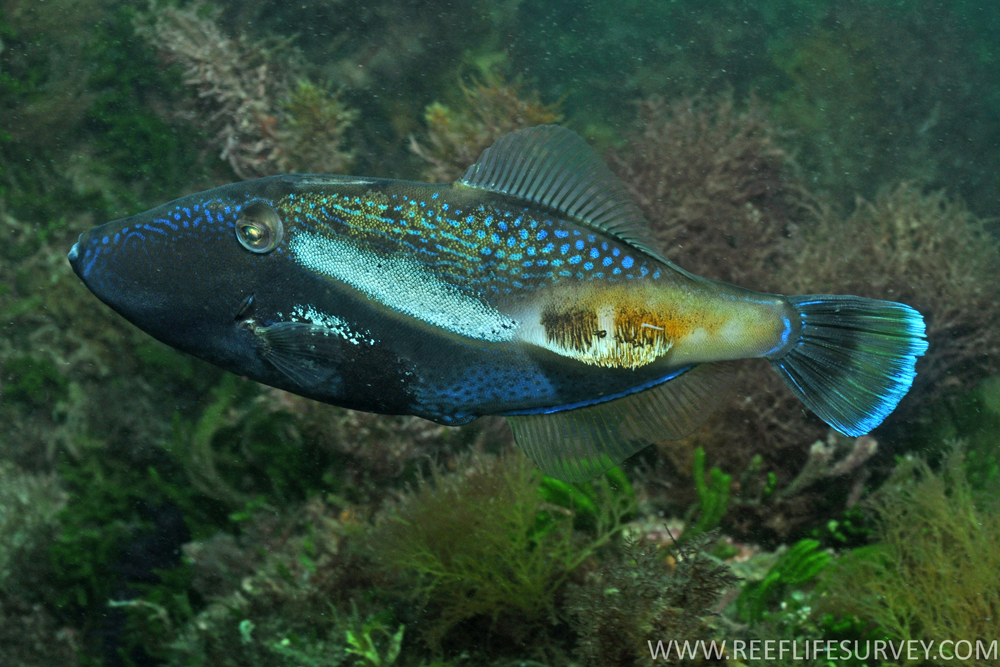Toothbrush Leatherjacket, Acanthaluteres vittiger (Castelnau 1873)

A male Toothbrush Leatherjacket, Acanthaluteres vittiger, on the Freycinet Peninsula, Tasmania. Source: Rick Stuart-Smith / Reef Life Survey. License: CC BY Attribution
Toothbrush Leatherjacket, Acanthaluteres vittiger (Castelnau 1873)
More Info
|
Distribution |
Endemic to southern Australia, from about Coffs Harbour, New South Wales, to north of Leeman, Western Australia, including Tasmania. The species is abundant in coastal waters of Victoria and Tasmania. Juvenile toothbrush leatherjackets inhabit shallow sheltered seagrass beds, and generally move to rocky reefs as they grow. Adults are more common on deeper reefs. Prior to settlement, larvae and small juveniles often shelter under floating seaweed before settling in seagrass beds. |
|
Features |
Dorsal fin II + 30-35 (second spine tiny); Anal fin 27-34; Caudal fin 12; Pectoral fin 11-13; Vertebrae 20. Body rather elongate in males, oblong, of moderate depth, somewhat deeper in females, very compressed, with ventral flap of moderate size; caudal peduncle shallow. Head large, acutely pointed; eyes small; mouth very small; teeth large, central pair in upper jaw truncate, those opposite in lower jaw somewhat more pointed; gill openings in form of small slit mostly above each pectoral fin base. Skin rather coarse to touch; midside of body in males with toothbrush-like patch of bristles, bristles poorly developed in females and juveniles; lateral line difficult to detect. Two dorsal fins, first dorsal above eyes, consisting of prominent four-edged spine with row of strong downward-directed barbs along each edge, spine wholly received into deep groove when depressed, second dorsal widely separated from first, of moderate length, moderately elevated anteriorly in males, outer margin slightly convex and not elevated anteriorly in females; anal fin similar to and opposing second dorsal; caudal fin truncate. Pectoral fins moderately small, rounded. Pelvic fins rudimentary, rudiment prominent, immovably attached to rear end of pelvis. |
|
Size |
To 32 cm. |
|
Colour |
Males brown to blackish blue, with numerous blue lines and spots; prominent white to pale blue band from each eye to toothbrush-like patch of bristles on side, similarly coloured blotch near pectoral fin; caudal fin dusky with pale rear border. Females yellowish brown to brown, usually with scattered pale blotches and dark brown spots on side of body. Juveniles similar to females but usually with broad white stripe extending from chin to caudal peduncle as well. |
|
Fisheries |
Taken and discarded as bycatch in the prawn trawl fishery of the Spencer Gulf, South Australia. |
|
Etymology |
The specific name vittiger is from the Latin vitta (= band, stripe) and -ger (= to bear, carry) in reference to the broad white stripe in juveniles that runs from the chin to the caudal peduncle: 'irregular but broad longitudinal band extends on each side from the snout to the tail'. |
|
Species Citation |
Monacanthus vittiger Castelnau 1873, Australia. 4. Fishes of South Australia. Proc. Zool. Acclim. Soc. Vict. 2: 81. Type locality: Gulf St Vincent, South Australia. |
|
Author |
Bray, D.J. 2022 |
|
Resources |















